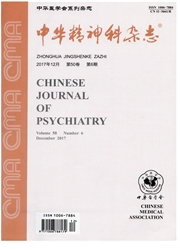

 中文摘要:
中文摘要:
目的探讨缺陷型与非缺陷型精神分裂症首次发病患者听觉事件相关电位P300的特征及与临床状态的相关性。方法采用Nihon Kohden脑诱发电位仪,检测50例首次发病非缺陷型精神分裂症患者(非缺陷组)、40例首次发病缺陷型精神分裂症患者(缺陷组)及50名正常对照(对照组)的P300并比较3组问差异;采用PANSS评估患者精神症状,大体功能评定量表(Global Assessment of Functioning Scale,GAF)评定患者的总体功能水平,控制性别、年龄、受教育年限,偏相关分析非缺陷组及缺陷组P300同各自临床特征的关系。结果与对照组比较,非缺陷组与缺陷组P300指标中的N1[对照组、非缺陷组、缺陷组分别为(100.0±14.3)、(115.5±29.1)、(115.0±15.1)ms]、P2[对照组、非缺陷组、缺陷组分别为(167.2±14.3)、(184.7±39.6)、(186.0±25.0)ms]、N2[对照组、非缺陷组、缺陷组分别为(214.3±18.4)、(242.8±44.9)、(240.3±33.7)ms]潜伏期均延长(F值分别为8.476、6.493、10.449);N1[对照组、非缺陷组、缺陷组分别为(10.7±4.6)、(6.9±5.9)、(7.2±2.7)uV]、N2[对照组、非缺陷组、缺陷组分别为(7.6±5.8)、(3.7±6.2)、(1.9±6.4)uV]波幅均降低(,值分别为8.610、11.651),按键反应的平均时间[对照组、非缺陷组、缺陷组分别为(357.4±50.2)、(508.6±139.1)、(546.7±482.4)ms]延长(F=6.349),差异均有统计学意义(P〈0.05);缺陷组和非缺陷组比较显示,非缺陷组P。潜伏期延长,缺陷组P3a潜伏期延长,差异均有统计学意义(P〈0.05),且与各自临床特征(病程、发病年龄、GAF总分及PANSS总分、PANSS阳性症状、PANSS阴性症状和PANSS一般精神病理)无相关性(非缺陷级r分别为0.195、-0.195、-0.121、0.078、0.236、-0.138?
 英文摘要:
英文摘要:
Objective To detect the P300 components of auditory event-related potentials in first episode deficit and non-deficit schizophrenia and the relationship between P300 and clinical variables. Methods P300 components of event-related potentials were measured in 50 patients with non-deficit schizophrenia ( NDS), 40 patients with deficit schizophrenia (DS) and 50 unrelated healthy controls (HC). The mental status of patients with schizophrenia was determined using the Positive and Negative Syndrome Scale (PANSS). The global functioning status was assessed using the Global Assessment of Functioning Scale (GAF). Partial correlations were computed to explore associations among the P300 and the clinical data when controlling for gender, age and education level in NDS and DS. Results Compared to HC group, both groups of NDS and DS showed significantly delayed N1 [ HC ( 100. 0 ± 14. 3 ) ms, NDS ( 115.5 ± 29. 1 ) ms,DS (115.0±15.1) ms], P2[HC(167.2±14.3)ms,NDS (184.7 ±39.6) ms,DS (186.0 ±25.0) ms] andN2[HC(214.3±18.4)ms,NDS (242.8 ±44.9) ms,DS(240.3±33.7) ms] latency (F= 8.476,6. 493,10. 449, respectively,P 〈 0. 05 ), significantly reduced N1 [ HC ( 10.7 ± 4. 6) uV, NDS (6. 9 ± 5.9) uV,DS ( 7.2±2.7)uV] and N2[HC(7.6±5.8) uV,NDS(3.7 ±6. 2) uV,DS (1.9 ±6. 4) uV] amplitude ( F = 8. 610, 11. 651, respectively, P 〈 0. 05 ), as well as significantly delayed button mean reaction time [ HC (357.4 ± 50. 2) ms, NDS (508.6 ± 139. 1 ) ms, DS (546. 7 ± 482. 4) ms ] ( F = 6. 349, P 〈 0. 05 ). While compared to HC group, only NDS group showed significantly delayed latency of P3b ( P 〈 0. 05) ,whereas, only DS group showed significantly delayed latency of P3a(P 〈0.05). No correlation was found between P3b latency and clinical variables ( course, age at onset, GAF score, PANSS total score, PANSS positive symptoms,PANSS negative symptoms and PANSS general psychopathology) in NDS (r = 0. 195, -0. 195
 同期刊论文项目
同期刊论文项目
 同项目期刊论文
同项目期刊论文
 期刊信息
期刊信息
